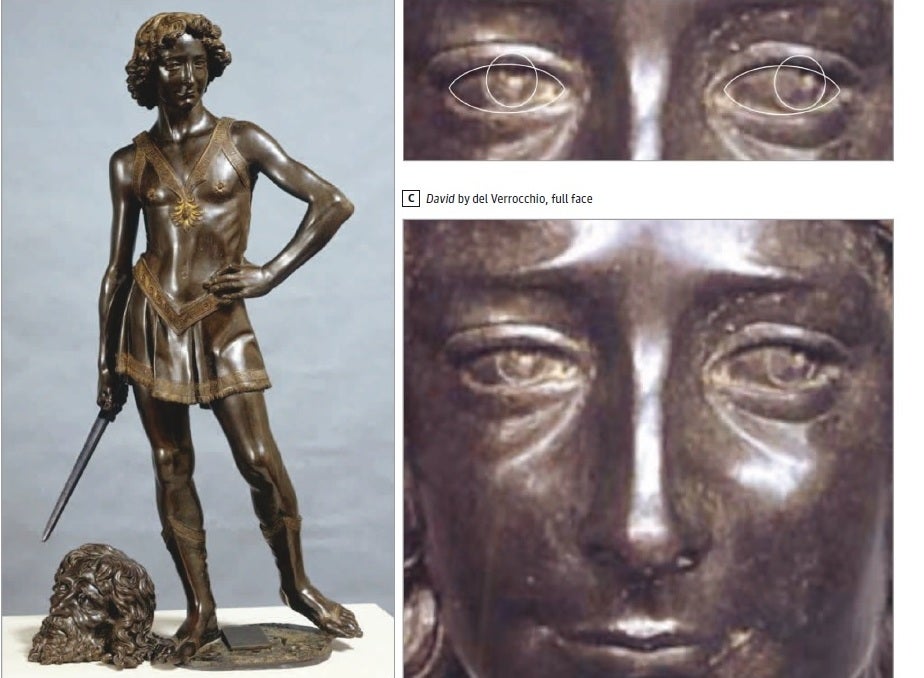Leonardo da Vinci may have had an eye disorder that helped him paint masterpieces
Measurements of self-inspired works show a tendency for the left eye to turn outward, suggesting the artist might have had a mild strabismus that helped him translate three-dimensional scenes to canvas
Your support helps us to tell the story
From reproductive rights to climate change to Big Tech, The Independent is on the ground when the story is developing. Whether it's investigating the financials of Elon Musk's pro-Trump PAC or producing our latest documentary, 'The A Word', which shines a light on the American women fighting for reproductive rights, we know how important it is to parse out the facts from the messaging.
At such a critical moment in US history, we need reporters on the ground. Your donation allows us to keep sending journalists to speak to both sides of the story.
The Independent is trusted by Americans across the entire political spectrum. And unlike many other quality news outlets, we choose not to lock Americans out of our reporting and analysis with paywalls. We believe quality journalism should be available to everyone, paid for by those who can afford it.
Your support makes all the difference.The painter, inventor and polymath Leonardo da Vinci may have had a squint that helped him capture the Mona Lisa’s smile and create his masterpieces, according to researchers.
Doctors from the Optometry and Vision Sciences School at City University of London have diagnosed the Renaissance master with strabismus after analysing the eye alignment of works believed to have been modelled, in part, on himself.
Strabismus is a common vision disorder where one of the eyes looks inward, outward, up or down when the other eyes is focused on an object.
The condition is thought to be beneficial to painters as it lets them better focus on close-up flat surfaces and has been identified in a number of famous artists, including Rembrandt.
There are notoriously few validated images of da Vinci and historians can only speculate on the extent he put himself into his work. However, Leonardo's own text the Codex Atlanticus says that artists can't help but be self inspired, stating: “[The soul] guides the painter’s arm and makes him reproduce himself, since it appears to the soul that this is the best way to represent a human being."
"A number of famous artists have been identified as having strabismus on the basis of the eye alignment evident from their self-portraits, including Rembrandt Harmenszoon van Rijn, Albrecht Dürer, Giovanni Francesco Barbieri (who was also known as Il Guercino, Italian for ‘the squinter’), Edgar Degas, and Pablo Picasso," the study’s author, neuroscientist Professor Christopher Tyler, said.

“Some forms of strabismus are thought to facilitate artistic work by suppressing the deviating eye, which creates two-dimensional monocular vision advantageous to painting and drawing”
While having two eyes focused on an object (stereoscopic vision) is integral to our depth perception, it can make translating three-dimensional scenes to canvas more tricky, as each eye will be seeing objects slightly to the right or left.
This can be illustrated by holding a finger in front of your nose and shutting your eyes alternately causing the digit to jump side to side.
If one eye deviates, the brain will deprioritise signals from the unfocused eye, preventing this effect and giving a more static image to work from.
For the study published in JAMA Ophthalmology, Professor Tyler measured the alignment in six art works believed to be partly self-inspired by fitting circles to the irises of each eye and measuring the average deviation from alignment.

Works included two drawings, two oil paintings and two sculptures. Among them his world famous Vitruvian Man sketch, the bronze sculpture David – reputedly a depiction of the young Leonardo– and Salvator Mundi, his painting of Jesus Christ which recently became the most expensive in history.
In all cases, the eye misalignment was measurable, though not severe and averaged a −10.3° deviation from the focussed eye across the six pieces.
This negative number means the eye would tend to look outwards (exotropia) and Professor Tyler argues that da Vanci’s strabismus may have been non-existent when focusing intently on an object, but would come in when he relaxed into painting. This would give him the best of both worlds.
The professor said: “The weight of converging evidence suggests that Leonardo had intermittent exotropia, with a resulting ability to switch to monocular vision.
“This would perhaps explain his great facility for depicting the three-dimensional solidity of faces and objects in the world and the distant depth recession of mountainous scenes.”

Join our commenting forum
Join thought-provoking conversations, follow other Independent readers and see their replies
Comments